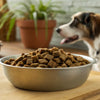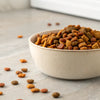How Much Does 1 Cup of Dry Dog Food Weigh? Understanding Dog Food Measurements for Your Furry Friend
- Houndsy
Table of Contents
- Introduction
- Understanding Dog Food Measurements
- The Weight of Dog Food: A Deeper Dive
- Best Practices for Measuring Dog Food
- Calculating Caloric Needs for Your Dog
- Conclusion
Introduction
Did you know that pet obesity has become a significant concern, affecting nearly 60% of dogs in the United States? As responsible pet owners, it’s crucial to ensure that our furry companions receive the right amount of food to maintain a healthy weight and overall well-being. However, accurately measuring dog food can be trickier than it seems.
When we say "1 cup of dry dog food," we often assume it weighs a standard amount. Yet, this weight can vary based on the type of kibble and its specific ingredients. In this blog post, we will dive into the question, "how much does 1 cup of dry dog food weigh?" and explore why precise measurements matter. We will also provide practical tips on how to measure dog food correctly, ensuring your pet receives the right nutrition every day.
By the end of this article, you’ll have a comprehensive understanding of dog food measurements, the implications of inaccurate feeding, and how our innovative Houndsy Kibble Dispenser can simplify the feeding process for you and your dog.
Understanding Dog Food Measurements
The Basics of Measuring Dog Food
At its core, measuring dog food accurately involves understanding both volume and weight. A standard measuring cup holds 8 fluid ounces, but when it comes to dry dog food, the actual weight can vary significantly. Generally, one cup of dry dog food weighs between 3 to 3.5 ounces (approximately 85 to 99 grams). However, factors such as kibble size, density, and moisture content can affect this measurement.
For example, larger kibble pieces may create more air pockets, resulting in a lighter weight per cup. Conversely, smaller, denser kibble can weigh more in the same volume. This variability highlights the importance of knowing exactly how much your specific brand of dog food weighs.
Why Accurate Measurements Matter
Precise measurement of dog food portions directly impacts your pet's health. Overfeeding can lead to obesity and associated health problems, while underfeeding may result in nutritional deficiencies. A study by the British Veterinary Association found that many owners do not measure their dog’s food accurately, which could contribute to these issues.
Furthermore, pet owners using volume-based measurements often inadvertently overfeed by 20-30%. This staggering statistic underscores the necessity of adopting a more accurate method of measuring food, such as using a digital kitchen scale.
The Weight of Dog Food: A Deeper Dive
Knowing Your Kibble
The first step to accurately measuring dog food is understanding the weight of the specific kibble you use. Many dog food brands provide this information on the packaging, indicating how much one cup of their food weighs. If this information is not available, you can measure it yourself with a kitchen scale.
Here's how to do it:
- Tare the Scale: Place your empty measuring cup on the scale and reset it to zero.
- Fill the Cup: Add dog food until you reach the desired volume (1 cup).
- Read the Weight: The scale will display the weight of the food in ounces or grams.
Converting Between Measurements
Understanding how to convert between volume and weight is essential, especially when trying to meet your dog's caloric needs. For example, if your dog food label states it has 3,000 kcal/kg, you can convert this to calories per ounce by dividing by the number of ounces in a kilogram (35.27):
- 3,000 kcal/kg ÷ 35.27 ≈ 85.06 kcal/ounce
From there, you can multiply the calories per ounce by the weight of food you're serving to determine how many calories your dog is consuming.
The Impact of Kibble Size and Density
Different brands of dog food have varying kibble sizes and densities, which can significantly affect how much a cup weighs. For instance, a cup of a large, airy kibble may weigh less than a cup of a smaller, compact kibble. It's essential to know the specifics of the kibble you're using to make accurate measurements.
Best Practices for Measuring Dog Food
Use a Digital Kitchen Scale
The most reliable method for measuring dog food is using a digital kitchen scale. Unlike measuring cups, scales provide consistent and accurate measurements, eliminating the variability introduced by different kibble shapes and sizes.
When using a digital scale, remember to:
- Zero the Scale: Always tare the scale with the cup or bowl before adding food.
- Measure by Weight, Not Volume: Focus on grams or ounces for the most accurate feeding portions.
- Avoid Heaping Portions: Keep food level in your measuring cup to ensure consistency.
Explore the Houndsy Kibble Dispenser
At Houndsy, we believe in making the dog feeding experience as convenient and beautiful as possible. Our flagship product, the Houndsy Kibble Dispenser, is designed for design-conscious pet parents who appreciate both form and function. With features like perfect portion control and a large storage capacity of 25-30 lbs, our dispenser eliminates the need for bending while providing a stylish addition to your home.
Calculating Caloric Needs for Your Dog
Understanding how much food to give your dog isn’t just about measuring; it’s also about knowing your dog’s caloric needs. Factors such as age, breed, weight, and activity level all play a role in determining how many calories your dog should consume daily.
Establishing a Baseline
To get a baseline for your dog's daily caloric needs, you can use a dog calorie calculator or consult with your veterinarian. Once you know how many calories your dog should eat, you can calculate the corresponding amount of food based on the caloric content of their specific diet.
Creating a Feeding Schedule
Once you determine your dog’s daily caloric intake, you can divide this into meals. For example, if your dog needs 500 calories per day, and the dog food contains 85 calories per ounce, you would calculate:
- 500 calories ÷ 85 calories/ounce ≈ 5.88 ounces per day
From here, you can divide that amount into the number of meals your dog receives.
Conclusion
Understanding how much 1 cup of dry dog food weighs is vital for ensuring your furry friend receives the appropriate nutrition. By using a digital kitchen scale and taking into account the specific characteristics of your dog food, you can create a consistent feeding routine that supports your dog’s health and well-being.
Additionally, with our elegant and functional Houndsy Kibble Dispenser, you can simplify the feeding process while enhancing your home decor. We invite you to explore our product and see how we can help elevate your dog feeding experience.
Frequently Asked Questions
How much does 1 cup of dry dog food typically weigh in ounces and grams?
One cup of dry dog food typically weighs between 3-3.5 ounces (85-99 grams), although this can vary based on the brand and kibble type.
What is the most accurate way to measure my dog's food portion—using a cup or a kitchen scale?
A kitchen scale is the most accurate method for measuring dog food portions, as it eliminates variables like kibble size and settling that can affect cup measurements.
How many cups of dry dog food are there in a 5, 10, or 20-pound bag?
Approximately, a 5-pound bag contains 15-20 cups, a 10-pound bag contains 30-40 cups, and a 20-pound bag contains 60-80 cups of dry dog food.
Why can the weight of 1 cup of dog food vary between different brands or types of kibble?
The weight varies due to differences in kibble size, density, shape, and moisture content between brands and types of dog food.
How can I convert cups of dog food into calories to ensure proper feeding amounts?
To convert to calories, multiply the grams per cup by the food's kilocalories per kilogram and then divide by 1,000. Always check your dog food's specific nutritional information for accurate calorie content.
By following these guidelines, you can ensure that you are providing your dog with the right amount of food, promoting their health and happiness. Explore our Houndsy Kibble Dispenser today to enhance your dog feeding experience!












